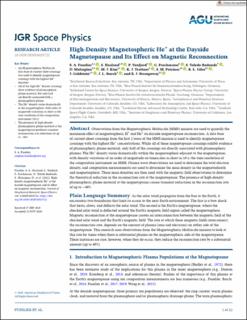High‐density magnetospheric He+ at the dayside magnetopause and its effect on magnetic reconnection
Fuselier, Stephen A.; Haaland, Stein; Tenfjord, Paul; Paschmann, G; Toledo-Redondo, S; Malaspina, D; Kim, M.J.; Trattner, K.J.; Petrinec, S. M.; Giles, B. L.; Goldstein, J; Burch, J. L.; Strangeway, R. J.
Journal article, Peer reviewed
Published version

Åpne
Permanent lenke
https://hdl.handle.net/11250/2765851Utgivelsesdato
2021Metadata
Vis full innførselSamlinger
Originalversjon
Journal of Geophysical Research (JGR): Space Physics. 2021, 126 (1), 2020JA028722 10.1029/2020JA028722Sammendrag
Observations from the Magnetospheric Multiscale (MMS) mission are used to quantify the maximum effect of magnetospheric H+ and He+ on dayside magnetopause reconnection. A data base of current-sheet crossings from the first 2 years of the MMS mission is used to identify magnetopause crossings with the highest He+ concentrations. While all of these magnetopause crossings exhibit evidence of plasmaspheric plume material, only half of the crossings are directly associated with plasmaspheric plumes. The He+ density varies dramatically within the magnetosphere adjacent to the magnetopause, with density variations of an order of magnitude on timescales as short as 10 s, the time resolution of the composition instrument on MMS. Plasma wave observations are used to determine the total electron density, and composition measurements are used to determine the mass density in the magnetosheath and magnetosphere. These mass densities are then used with the magnetic field observations to determine the theoretical reduction in the reconnection rate at the magnetopause. The presence of high-density plasmaspheric plume material at the magnetopause causes transient reductions in the reconnection rate of up to ∼40%.